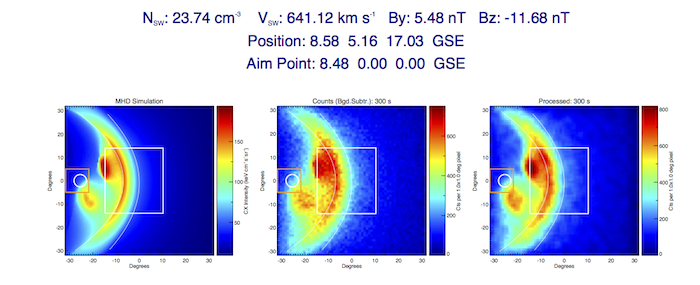SMILE
SMILE
Information
SMILE video & logo
Other websites
SMILE Twitter


SUMMARY
SMILE is a space mission which aims to measure Earth's global system responses to solar wind and geomagnetic variations.
SMILE will investigate the dynamic response of the Earth's magnetosphere to the impact of the solar wind in a unique manner, never attempted before: it will combine soft X-ray imaging of the Earth's magnetopause and magnetospheric cusps with simultaneous UV imaging of the Northern aurora.
For the first time we will be able to trace and link the processes of solar wind injection in the magnetosphere with those acting on the charged particles precipitating into the cusps and eventually the aurora.
SMILE will also carry in-situ instrumentation to monitor the solar wind and magnetosheath plasma conditions, so that the simultaneous X-ray and UV images can be compared and contrasted directly, and self-sufficiently, with the upstream and local driving conditions.
With its unparallelled payload SMILE will provide answers to many of the open questions in solar-terrestrial relationships in a thoroughly novel way.
SMILE was put forward in March 2015 in response to the European Space Agency and Chinese Academy of Sciences joint call for a small-size space mission. The Executive Summary of the submitted proposal can be found here.
Out of 13 missions originally proposed, SMILE was the one chosen for an initial study phase during the summer of 2015. An initial study of the whole mission was carried out by ESA and CAS at their Concurrent Design Facilities during October 2015, and the conclusion was that the mission is feasible, with no show stoppers. In early November 2015 SMILE was formally selected by the ESA Science Programme Committee (SPC).
We are now in Phase B-C of the project. The SMILE Mission System Requirements Review was successfully closed in early October 2018, the SMILE Definition Study Report (the Red Book) was published in December 2018, and Mission Adoption by the ESA SPC was granted in early March 2019. This means that SMILE is now formally part of ESA's Cosmic Vision programme and has received the green light for implementation. Platform and instruments have successfully gone through their Preliminary Design Review (2021) and are now preparing for the Critical Design Review and Flight Model build. Launch is expected to take place in early 2025.
Scientists and engineers from the UK, China, Canada, several European countries and the US are collaborating in order to make SMILE a reality.
Please join our team of supporters by following this link.

Above is a series of simulated images for the SMILE Soft X-ray Imager (SXI). On the left is an image of simulated X-ray emission, constructed using input from a magnetohydrodynamic model of the dayside magnetosheath. This simulation was run for a period of solar wind that followed a southward turning of the interplanetary magnetic field. The middle image shows raw SXI counts, integrated over 300 seconds. On the right hand side is the SXI counts image following a step of image deconvolution to account for blurring by the point spread function of the SXI optical system. The SXI field of view for a nominal pointing position is shown by the white square. The UV Imager field of view is shown by the orange square. The approximate magnetopause and bow shock boundaries, plus the position of the Earth, are also overlaid on the images in white.
More information about the SXI simulations can be found at this link.